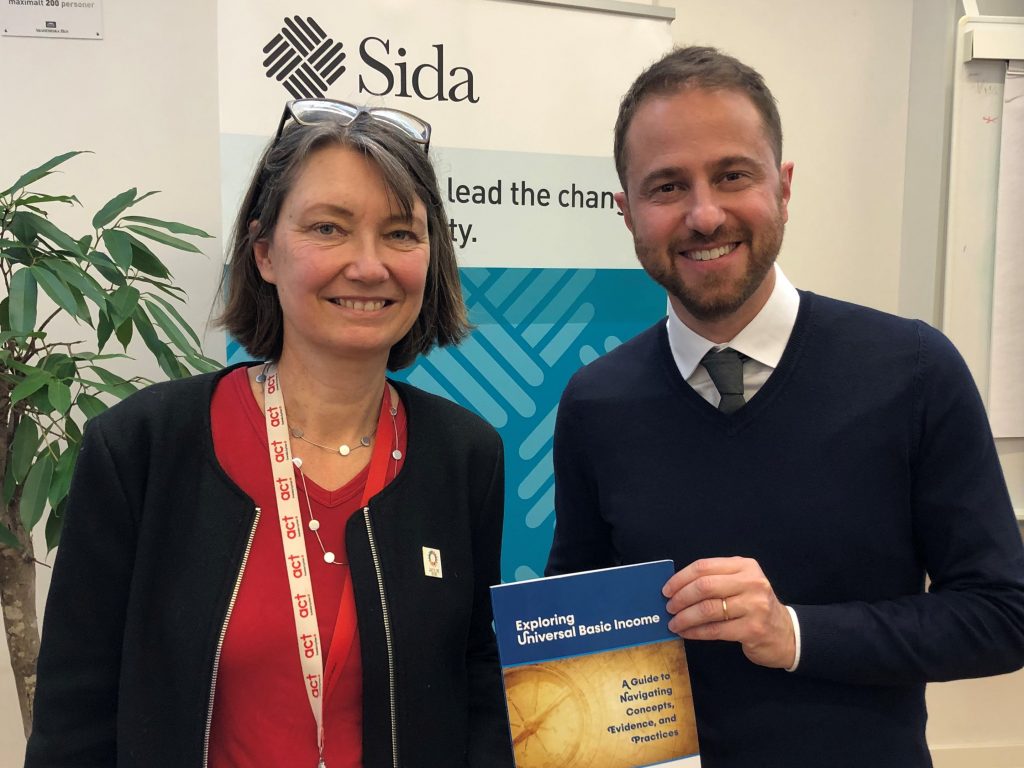The World Bank recently published a report on Universal Basic Income. In her comments, Gunnel Axelsson Nycander appreciates several aspects of the report, but also points at issues that are missing.
Updated March 31 2020

The World Bank is not known for promoting universal social protection. Rather, it is seen as one of the strong supporters of poverty targeting. To many it would, therefore, have come as a surprise when it recently published Exploring Universal Basic Income. A Guide to Navigating Concepts, Evidence, and Practices.
It is an ambitious report that includes a lot of information and analysis on a range of issues related to the introduction of Universal Basic Income (UBI). I especially enjoyed the analysis of the effects on labor market, as well as the discussion on the relevance of environmental taxes and abolishment of subsidies of fossil fuels.
At a more general level, I appreciate the approach taken by the authors in two ways:
1. The analysis is global, that is, Northern as well as Southern contexts are discussed in the report. I have always found it problematic when social protection in developing countries is seen as something different than social protection in countries like my own (Sweden). In fact, since day one, when I started to learn about the experiences from cash transfers in developing contexts, I could recognize the same fundamental questions which form a regular part of the political debate in my part of the world. The contexts are of course different, but the fundamental issues to balance are the same: What incentives do the social programs create? Are the programs based on charity or rights? Do they contribute to stigma? Etc.
2. Also, UBI is treated as the far end of a continuum, but fundamentally not different from other social protection instruments. In that way, many parts of the analysis become relevant for other instruments – at various degrees of coverage or conditionalities and sanctions.
What about UBI then? The report gives a good overview of the growing number of studies and experiments. It doesn’t argue for or against but highlights several aspects that need to be considered if one wants to implement a UBI.
If I were passionate about UBI, I would certainly have a lot of comments about this analysis. But I’m not. I am, however, passionate about universal social protection such as universal pensions, child benefits and free education. This passion is supported by academic research and based on the lived experience of having grown up, and raised my own children, in Scandinavia.
Consequently, it should be no surprise that my two major concerns with Exploring Universal Basic Income are linked to the issues of universality vs targeting, as I explain below:
Poverty targeting is not easy and may have many negative side effects. A recent study shows that it is impossible to target small coverage programs to the “most needy” with any degree of accuracy. Further drawbacks with targeting are, however, not discussed in depth in the World Bank report. For example, the risks of corruption and of capture by local elites in poverty targeted programs are given very little attention in the discussion on limited coverage (p 27-28).
1. The disadvantages of poverty targeting are not taken seriously in the report
The way we look at targeting has direct implications on the interpretation of the result of the simulations undertaken in Chapter 4 of the report. The conclusion that a UBI will give “less money to more people” assumes that poverty targeting is working. But we know it isn’t. That is, for those very many people living in poverty who are erroneously excluded from current income-tested programs, a UBI would be a huge improvement. The conclusion of the simulations should rather be “some money for those that are currently left behind by poverty targeting”.
A concrete illustration of this point can be found on page 143: “In Mozambique, India, Indonesia, and Russia, replacing selected social assistance programs and subsidies with a UBI would allow for financing the equivalent benefits scenario — which, in most cases, would still deliver relatively low poverty impacts.” (The “equivalent benefits scenario” means that the level of investment in existing social programs is chosen as the level of a UBI in a specific scenario.) Whereas the World Bank authors conclude that these benefits in this scenario are too small to have a major impact on poverty, my conclusion would be that in these countries it is indeed possible to finance universal pensions or child benefits.
2. The positive experiences of universal lifecycle programs are not considered enough
The advantages of universal programs are, as with the disadvantages of targeting, not discussed at depth. A key argument for universality is that broad programs – such as free health care, universal old age pension or child grants – can bring together the interests of different groups and foster alliances, including those living in poverty with the higher tax-paying middle class. Whenever the authors touch upon this argument (see for example pages 26 and 44), it is, however, made with reservations like “could”, “maybe”, or “some argue” – as if this were just a theory.
“Hello!” I would like to say to the authors. “This is not just a theory. I am that middle class. I am happy to pay taxes, because I know I receive child benefits, free education and good health services.” I am not arguing that universal programs will necessarily always lead to broad alliances with the middle class. But it is a fact, rather than a theory, that these alliances do exist in many countries.
Likewise, the authors fail to recognise the redistribution paradox) – that universal social programs will give poor people more money in absolute terms than “pro-poor programs”. The explanation for the “paradox” is that universal programs tend to have larger budgets when the middle class benefit from schemes and feel that they are receiving something in return for the taxes.
The redistribution paradox and the role of the middle class can only be understood if government revenues are regarded as dynamic. In Chapter 5 on financing, however, the authors discuss taxes as if they were static. Therefore, they do not discuss issues like: How does the design of social protection – especially if it is universal or not – influence the willingness to pay taxes? I would argue that access to universal benefits – like child benefits, health care, education and pensions – will, over time, influence the willingness to pay taxes. In fact, this is a key mechanism in the Scandinavian model of a welfare society.
Again, I am this middle class. I am willing to pay my taxes when I know that I will benefit from them. I don’t need to spend my money on private health insurance or education, because I have access to universal programs.
A final note on taxes. The report includes shocking figures of the extremely modest income tax on the richest populations in the countries included in the simulations: less than 10 per cent (p 144). The authors’ conclusion is that it is politically unrealistically to increase taxes as much as would be needed for a UBI. My conclusion would rather be that the tax levels should indeed be raised and for a number of reasons. It would indeed be politically difficult to raise them dramatically. But over time, there should be a considerable potential to increase tax collection in these countries!
Whose history?
As a student of economic history myself, I appreciated the historic perspective given in Chapter 1. However, the “glimpse of history” is so small that it gives an inaccurate picture. By only referring to the development of social security in the UK, the section misses, for example, the longer history of social security, where churches and other religious institutions have played a major role, as well as the Scandinavian model.
It would have been more useful if the author had referred to a standard typology of social protections systems – “the three_worlds_of_welfare_capitalism” – rather than the “four phases” (which may give the impression that all countries go through the same phases).
Rights based social protection?
A brief comment towards the end of the report (P 217) highlights a fundamental question about what social protection is: “A UBI is distinct from a typical social protection program, because of both its universal nature and its provision of payments as a right, rather than as a discretionary benefit.”
“Wait a minute!” I would like to say again to the authors. Social protection is a right! It is there in the UN Universal Declaration of Human Rights, it is there in the covenant on Economic, social and cultural rights (ESCR), it is there in the Convention on the Rights of the Child, in CEDAW and the ILO’s Recommendation 202 on social protection floors. In most recommendations on social protection that I have seen, the “rights based” aspect, and the anchoring in national law, is key.
The fact that the authors of the report do not see social protection as a right may confirm many peoples’ suspicion that the World Bank is indeed approaching this field from a charity, rather than a citizens’ rights perspective.
Conclusion
The report has not convinced me that a UBI is, in general, a better option than a lifecycle-based universal system such as the one we have in Sweden. After reading the report, I see four (possibly overlapping) situations where a UBI would be useful:
- As a stepping-stone or gap filler towards the development of a comprehensive social protections system;
- Where informal jobs are pervasive;
- Where there is considerable income from the taxation of extractive industries to distribute; and,
- Where there is a need to reform major subsidy programmes without causing political disruption, as happened in 2011 in Iran, when it introduced a UBI.
To conclude, the report is an impressive piece of work. In future, I would love to see I similarly nuanced analysis, and simulations, of the various aspects and issues of universal child benefits and old age pensions. These programs are less utopian than UBI and are higher on the policy agenda of many countries. Unfortunately, the World Bank is actively discouraging such programs, pushing for poverty targeting. An in-depth analysis of the pros and cons of universal programs would probably put an end to this.
This blog is based on comments given by Gunnel Axelsson Nycander at a launch of the World Bank study in February 2020 in Stockholm.
The blog is also published by Development Pathways
Ugo Gentilini, editor and one of the authors of the report, commented on this blog on March 14. A response to his comments is posted here.

Lämna ett svar